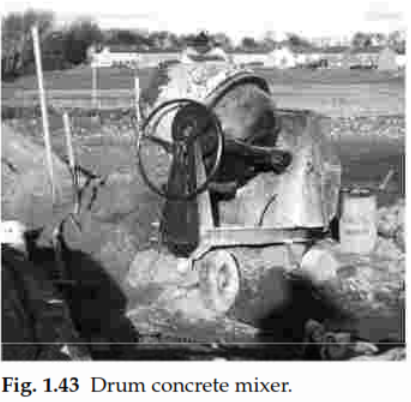Mixing Of Mortar | How to Mix Mortar?
The mix of ingredients is usually done in a mechanical concrete mixer. The term ‘cement mixer’ is frequently used but quite incorrect. Dry ingredients are placed in the drum and mixed to a uniform color.
The water is eventually added and the mixture gives a uniform consistency. Never mix beyond that point. Mixing for longer than necessary to give a uniform consistency adds a great deal of air to the mix, which weakens the mortar.
The mortar should never be remixed or the old mortar should be introduced to the fresh batch. Older mortars should not be ‘freshened up’ or ‘knocked up’ by adding too much water. After adding water to a batch of ingredients, the chemical setting of the ‘setting’ begins.
It takes about 3 hours to reach the ‘initial’ set. This goes beyond the fact that mortar can no longer be used for building. In practice, mortar should be used within two hours of mixing.
The schematics of drum-like concrete mixers and pan mill mixers are shown in Figure 1.42, And a photograph of a drum mixer is shown in Figure 1.43. Black ash or old soft bricks were usually assembled for mortar instead of washed building sand.
These were placed in a pan mill with rollers heavier than paddles. These rollers are first crushed into bricks or ash pellets, then binder and water are added and rollers are squeezed to the sides and mixed to equal consistency.

During this period mortar is mostly lime mortar or cement/lime mortar, Lime is bought in ‘slacked lime’ and pebbles. Slacked limestones can be ground Down in the pan mill with ash or brick and water, yields a ‘fatty’ mortar.
Black ash is no longer used as a whole. The corrosion of ferrous and galvanic fittings has been proven to be a problem due to the presence of invasive minerals from black ash, especially sulfates which cause the deterioration of the OPC binder.
Soft, broken bricks are no longer used as a whole, a supply of washed building sand Cheap and easily available. Pan mill mixers are no longer used with rollers, but horizontal pan mixers and their modern equivalent turbo mixers are used. Both types use paddles to ‘stir’ the ingredients.
The paddles can be rotated with a pan fix or the paddles can be fixed and the pan rotated. The gaging box should be used to ensure a proper and consistent ratio in the mix.
It is a four-sided box that is placed on a clean board and filled once with a binder. The
The box is lifted up, replaced with a board, and filled with sand five times. Six volumes are shoved into the mixer and the result is a 1: 5 mortar. Figure 1.44 illustrates the technique.
Mortar can be mixed by hand but only for small work. Consistency between Batches is difficult to achieve by hand mixing. Measurement boxes should be used and Mix the dry ingredients on a cardboard with a shovel, turning the pile onto at least three times.
You can watch this for a better understanding:
Water is added and the whole mixed to an even consistency. Loss of binder frequently
occurs when hand mixing and, in consequence, many operatives put more OPC into
the mix just in case it is lost.
The loss is carelessness and a better mixing technique should be employed, with no additional binder added as the mix might well end up being too strong.
Also Read:

